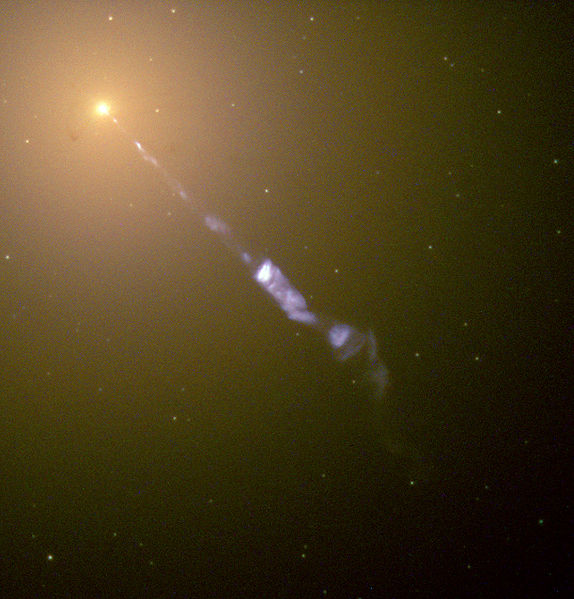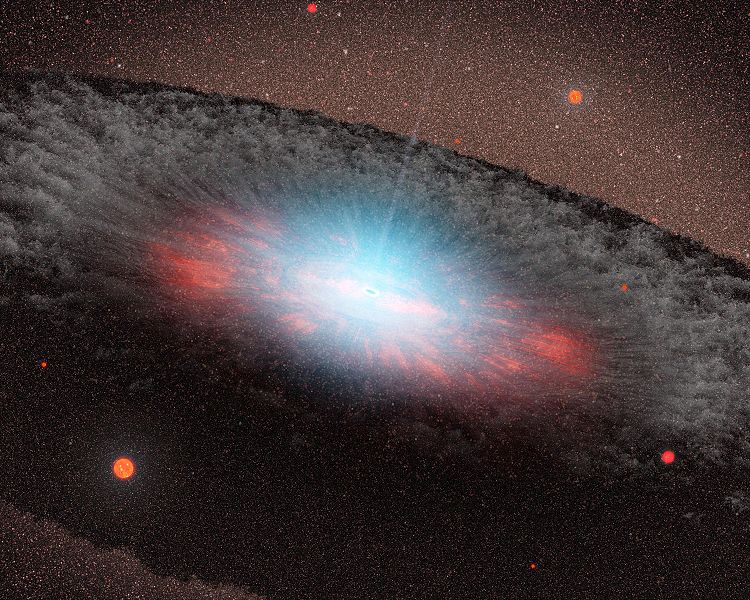Added 1 new A* page:Remember I was mentioning antimatter recently, and maybe how it's hard to make—like, you get it in supernovas, and in very small quantities in particle accelerators. Well if NASA's interpretation of readings from their FERMI Gamma-ray Space Telescope are correct, then antimatter also comes from thunderstorms! In tiny amounts, of course... But anyway, the theory is that really really fast electrons—near the speed of light—rocket out of the storm cloud; when they hit something, that releases energy in the form of gamma rays, which, if they hit another particle, can create an electron/positron pair (the positron being the antimatter form of an electron). Here's a rather nifty video they put together showing the theory in action:
(view in NASA's video gallery)
~~~~~~~~
If you've poked around the A* forum a bit you may remember that seeing a photo and reading about the 5000-light-year-long jet shooting out of the supermassive black hole at the center of galaxy Messier 87

image by NASA/ESA (source)
was the kick-off inspiration for me to make A*. Well, M87's supermassive black hole is in the news! It seems that by tracking the speeds of stars going around it, astronomers have been able to measure the hole's mass more precisely, to about 6.6 billion solar masses—I think this was announced at the American Astronomical Society meeting that just happened here in Seattle.
I haven't found a video of that—maybe they don't have the data in visual form, I dunno—which is too bad, because the ESO's video of stars going around A*—the supermassive black hole at the center of our galaxy, the Milky Way—is pretty neat:
https://www.youtube.com/watch?v=r3qSr5HmGkI
Our A*, though, is only about 4 million solar masses. :P Anyway, the wired.com article I linked there mentions that some day they're hoping to be able to see M87's black hole by detecting the slightly dimmer area at the center of that galaxy's active nucleus, where it should be blocking—or swallowing—light from the stars on its far side. Although it's supposedly three times the size of the orbit of Pluto—which is really big—I gotta think that's still going to be tough to spot. It will sure be neat if they do, though.
I also thought this NASA artist's rendition of what M87's supermassive black hole might look like

artist's concept by NASA (source)
was interesting, not so much because of the questionable lumpiness of the dust in its accretion disc, or the remarkably clear view in what I would have thought would be an area of space pretty much obscured by dust and superheated gasses and so forth, or the reddish light below the blue of the jet, which would represent light red-shifting as it gets sucked toward the singularity, but because you can see how they tried to represent the density of stars in a galactic core, which is something I've been wrestling with in A*; the problem with how they've done it, which is probably the most accurate way, is that the stars are so small and dense that they just end up looking like a static pattern, and it's really hard to discern anything. Probably the closest I came to drawing stars that way was page 83 of this episode

which I was reasonably happy with, but it did take a long time to draw, and probably only worked because I masked the stars off from the central ship with a big dust cloud or whatever in the background; I also cheated by a) making the dense star area cover only part of the sky and b) leaving relatively star-free areas around the ships in the background so you could see them. So since then I've been compromising on bigger, more interspersed stars, which are easier to draw and seem to be easier to look at. (Come to think of it, the larger stars I'm doing look kinda like the ones in that ESO A* video above.) Maybe I'll be able to come up with a technically more accurate rendition at some point, I dunno. :P
|
